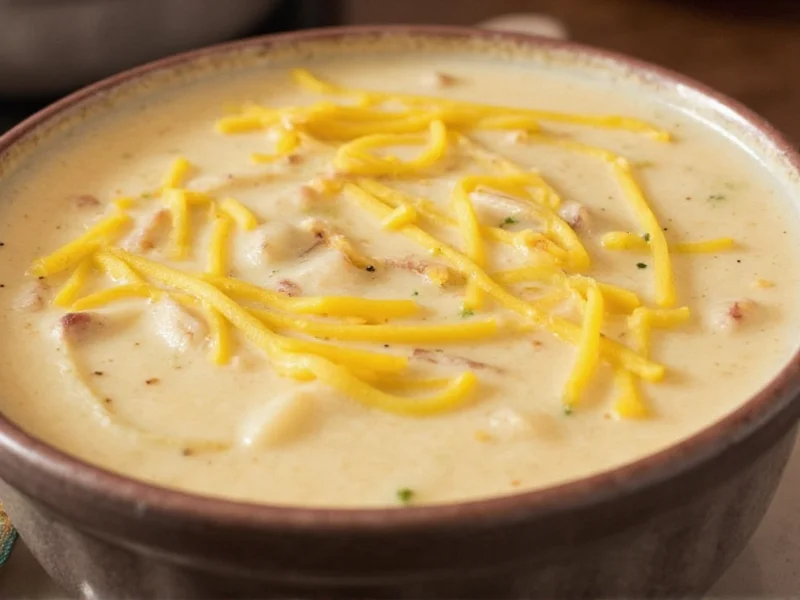Why This Copycat Recipe Works
Creating an accurate Outback Steakhouse potato soup at home requires understanding what makes their version distinctive. Unlike basic potato soups, Outback's version has a unique texture—creamy yet with discernible potato pieces, rich from cheese and cream but not overly heavy, and featuring that signature smoky bacon flavor throughout. The secret lies in the layering of flavors and proper potato preparation.
Essential Ingredients for Authentic Flavor
Using quality ingredients makes all the difference in achieving that restaurant-quality taste. Here's what you'll need for an accurate Outback potato soup copycat recipe:
| Ingredient | Amount | Key Purpose |
|---|---|---|
| Yukon Gold potatoes | 2 lbs, peeled and diced | Provides creamy texture while holding shape |
| Thick-cut bacon | 6 slices, chopped | Creates smoky base flavor (save 2 tbsp fat) |
| Yellow onion | 1 large, finely diced | Essential sweetness and depth |
| Garlic cloves | 3, minced | Subtle aromatic foundation |
| Chicken broth | 4 cups low-sodium | Clean flavor base (better than vegetable broth) |
| Heavy cream | 1 cup | Creates signature richness |
| Sharp cheddar cheese | 1 cup shredded | Authentic cheesy flavor (not mild cheddar) |
| Green onions | 6, sliced | Finishing touch for freshness |
| Paprika | 1 tsp | Subtle smokiness |
| Cayenne pepper | ¼ tsp | Signature Outback "kick" |
Step-by-Step Preparation Guide
Follow these precise steps for the most accurate Outback Steakhouse potato soup copycat recipe. Proper technique matters more than you might think for achieving that distinctive texture and flavor profile.
Preparing the Flavor Base
- Cook bacon in a large pot until crisp. Remove bacon, leaving 2 tablespoons of fat in the pot
- Add onions to bacon fat and cook over medium heat for 8-10 minutes until deeply caramelized (this step is crucial for authentic flavor)
- Add minced garlic and cook for 1 minute until fragrant
- Stir in paprika and cayenne pepper, cooking for 30 seconds to bloom the spices
Cooking the Potatoes
- Add diced Yukon Gold potatoes and chicken broth to the pot
- Bring to a boil, then reduce heat and simmer for 15-18 minutes until potatoes are tender but not falling apart
- Reserve 1 cup of cooked potatoes, then use an immersion blender to partially puree the remaining soup (this creates the signature creamy-yet-chunky texture)
Finishing the Soup
- Return reserved potato pieces to the pot
- Add heavy cream and shredded cheddar cheese, stirring until cheese melts completely
- Stir in half the cooked bacon
- Season with salt and black pepper to taste (be careful with salt as bacon and cheese add sodium)
- Garnish with remaining bacon and sliced green onions before serving
Pro Tips for Perfect Outback-Style Potato Soup
- Don't skip the caramelization: Properly caramelized onions (cooked slowly until golden brown) create the soup's flavor foundation
- Yukon Golds are essential: Their naturally buttery flavor and creamy texture when cooked make them superior to Russets for this recipe
- Partial puree technique: Blending only part of the soup creates that distinctive Outback texture—creamy with potato chunks
- Cheese matters: Use freshly shredded sharp cheddar; pre-shredded cheese contains anti-caking agents that prevent smooth melting
- Rest before serving: Let the soup sit for 15 minutes after preparation—this allows flavors to meld and texture to stabilize
Common Variations and Substitutions
While this copycat outback potato soup recipe stays true to the original, these adjustments work well for dietary needs or preferences:
- Dairy-free version: Substitute coconut cream for heavy cream and omit cheese (add 2 tbsp nutritional yeast for cheesy flavor)
- Vegetarian option: Replace bacon with smoked paprika (2 tsp) and use vegetable broth (though it won't be identical to Outback's version)
- Lighter version: Use half-and-half instead of heavy cream and reduce cheese to ½ cup
- Extra hearty soup: Add 1 cup of cooked, diced ham along with the reserved potatoes
Serving Suggestions
For the complete Outback Steakhouse experience when serving your homemade potato soup:
- Serve in pre-warmed bowls to maintain temperature
- Offer with a side of fresh sourdough bread or Outback's signature Bloomin' Onion
- Garnish with extra green onions and a sprinkle of crispy bacon right before serving
- Pair with a simple green salad for a complete meal
Storage and Reheating Instructions
Proper storage maintains the soup's quality for later enjoyment:
- Refrigeration: Store in airtight container for up to 4 days
- Freezing: Freeze without dairy for up to 3 months; add cream and cheese when reheating
- Reheating: Warm gently over medium-low heat, stirring frequently. If soup thickens too much, add splashes of broth or cream
- Important: Avoid boiling when reheating, as this can cause the dairy to separate
Troubleshooting Common Issues
Even experienced cooks encounter challenges with this recipe. Here's how to fix common problems:
- Soup is too thin: Simmer uncovered for 5-10 minutes to reduce, or create a slurry with 1 tbsp cornstarch and 2 tbsp cold water
- Soup is too thick: Gradually add warm broth or cream until desired consistency is reached
- Cheese isn't melting smoothly: Remove soup from heat before adding cheese, and use freshly shredded cheese (not pre-shredded)
- Soup lacks depth: Add a splash of Worcestershire sauce or an extra pinch of smoked paprika
- Soup tastes bland: Balance with small amounts of salt, acid (lemon juice), or umami (Worcestershire)











 浙公网安备
33010002000092号
浙公网安备
33010002000092号 浙B2-20120091-4
浙B2-20120091-4